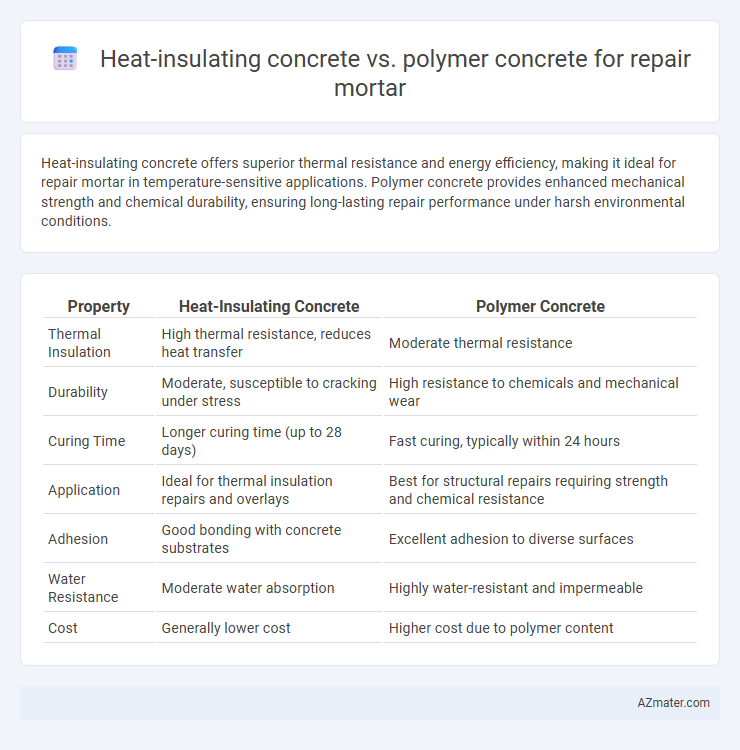Heat-insulating concrete offers superior thermal resistance and energy efficiency, making it ideal for repair mortar in temperature-sensitive applications. Polymer concrete provides enhanced mechanical strength and chemical durability, ensuring long-lasting repair performance under harsh environmental conditions.
Table of Comparison
| Property | Heat-Insulating Concrete | Polymer Concrete |
|---|---|---|
| Thermal Insulation | High thermal resistance, reduces heat transfer | Moderate thermal resistance |
| Durability | Moderate, susceptible to cracking under stress | High resistance to chemicals and mechanical wear |
| Curing Time | Longer curing time (up to 28 days) | Fast curing, typically within 24 hours |
| Application | Ideal for thermal insulation repairs and overlays | Best for structural repairs requiring strength and chemical resistance |
| Adhesion | Good bonding with concrete substrates | Excellent adhesion to diverse surfaces |
| Water Resistance | Moderate water absorption | Highly water-resistant and impermeable |
| Cost | Generally lower cost | Higher cost due to polymer content |
Introduction to Repair Mortars
Repair mortars are specialized materials designed to restore the structural integrity and surface quality of damaged concrete elements. Heat-insulating concrete incorporates lightweight aggregates and insulating additives to reduce thermal conductivity, making it ideal for applications requiring temperature regulation. Polymer concrete utilizes polymer resins as binders, offering superior adhesion, chemical resistance, and durability, beneficial for high-performance repair needs.
Overview of Heat-Insulating Concrete
Heat-insulating concrete is designed to reduce thermal conductivity in repair mortar applications, providing effective insulation properties that protect structures from temperature fluctuations and energy loss. Its composition typically includes lightweight aggregates and insulating additives such as expanded perlite or vermiculite, which enhance thermal resistance without compromising mechanical strength. This type of concrete is favored for repairing building elements exposed to extreme temperatures, improving energy efficiency and durability compared to standard mortars.
Key Properties of Polymer Concrete
Polymer concrete exhibits superior adhesion, chemical resistance, and rapid curing compared to heat-insulating concrete, making it ideal for repair mortar applications. Its low permeability and high compressive strength enhance durability and structural integrity under aggressive environmental conditions. The thermal expansion coefficient of polymer concrete closely matches that of traditional concrete, reducing the risk of cracking during temperature fluctuations.
Thermal Performance Comparison
Heat-insulating concrete demonstrates superior thermal resistance with lower thermal conductivity values, typically ranging from 0.1 to 0.3 W/m*K, effectively reducing heat transfer in repair mortar applications. Polymer concrete exhibits moderate thermal insulation properties, with conductivity values generally higher, around 0.3 to 0.5 W/m*K, but provides enhanced mechanical strength and chemical resistance. Selecting heat-insulating concrete for repair mortar prioritizes energy efficiency and temperature regulation, while polymer concrete balances thermal performance with durability and protective qualities.
Mechanical Strength and Durability
Heat-insulating concrete offers moderate mechanical strength with enhanced thermal resistance, making it suitable for repairing structures exposed to temperature variations. Polymer concrete exhibits superior mechanical strength and exceptional durability due to its enhanced chemical resistance and reduced permeability, ensuring long-lasting repair performance under harsh environmental conditions. The choice between heat-insulating and polymer concrete depends on balancing thermal insulation needs with the required load-bearing capacity and environmental exposure.
Application Methods and Workability
Heat-insulating concrete offers superior thermal resistance and is applied using traditional troweling and casting methods, which require careful moisture control to maintain workability and prevent cracking. Polymer concrete, contrastingly, utilizes polymer resins as binders, allowing for faster curing times and enhanced adhesion when applied via spraying or troweling, significantly improving workability in repair mortars. The selection between heat-insulating and polymer concrete depends on the repair site's temperature requirements and application complexity, with polymer concrete providing greater flexibility for intricate repairs due to its excellent flow and bonding characteristics.
Cost-Efficiency Analysis
Heat-insulating concrete offers superior thermal resistance with moderate material costs, making it a cost-efficient choice for energy-saving repairs in buildings. Polymer concrete, while generally more expensive due to synthetic resins, provides enhanced mechanical strength and chemical resistance, reducing long-term maintenance expenses. Evaluating lifecycle costs, heat-insulating concrete is preferable for projects prioritizing insulation and budget constraints, whereas polymer concrete suits applications demanding durability and minimal repair frequency.
Environmental and Sustainability Factors
Heat-insulating concrete offers improved energy efficiency by reducing thermal bridging and lowering heating and cooling demands, which significantly cuts carbon emissions over a building's lifecycle. Polymer concrete, while providing excellent chemical resistance and durability, often relies on synthetic resins derived from non-renewable sources, raising concerns about environmental impact and recyclability. Evaluating repair mortar options, heat-insulating concrete typically presents a more sustainable choice due to its enhanced insulation properties and lower embodied energy compared to polymer concrete.
Common Use Cases and Industry Examples
Heat-insulating concrete is commonly used in construction projects requiring thermal resistance, such as building facades, industrial furnaces, and pipeline insulation, benefiting energy-efficient buildings and infrastructure. Polymer concrete, renowned for its superior chemical resistance and rapid curing properties, is frequently applied in repairing sewer systems, chemical plants, and industrial floors where durability and fast turnaround are critical. Industries like automotive manufacturing and oil refineries often choose polymer concrete for repair mortars due to its exceptional bonding strength and resistance to corrosion, while heat-insulating concrete is favored in residential and commercial building restorations to enhance energy conservation.
Choosing the Right Material for Your Project
Heat-insulating concrete offers excellent thermal resistance, making it ideal for repair mortar in structures requiring energy efficiency and temperature regulation, such as exterior walls and industrial facilities. Polymer concrete provides superior chemical resistance and mechanical strength, suited for harsh environments like wastewater treatment plants or areas exposed to aggressive chemicals. Choosing the right material depends on project-specific factors including thermal insulation requirements, exposure conditions, and the durability needed to ensure long-term performance.

Infographic: Heat-insulating concrete vs Polymer concrete for Repair mortar
 azmater.com
azmater.com